Shaping the Future of the NC State EMG Program
go.ncsu.edu/readext?1085538
en Español / em Português
El inglés es el idioma de control de esta página. En la medida en que haya algún conflicto entre la traducción al inglés y la traducción, el inglés prevalece.
Al hacer clic en el enlace de traducción se activa un servicio de traducción gratuito para convertir la página al español. Al igual que con cualquier traducción por Internet, la conversión no es sensible al contexto y puede que no traduzca el texto en su significado original. NC State Extension no garantiza la exactitud del texto traducido. Por favor, tenga en cuenta que algunas aplicaciones y/o servicios pueden no funcionar como se espera cuando se traducen.
Português
Inglês é o idioma de controle desta página. Na medida que haja algum conflito entre o texto original em Inglês e a tradução, o Inglês prevalece.
Ao clicar no link de tradução, um serviço gratuito de tradução será ativado para converter a página para o Português. Como em qualquer tradução pela internet, a conversão não é sensivel ao contexto e pode não ocorrer a tradução para o significado orginal. O serviço de Extensão da Carolina do Norte (NC State Extension) não garante a exatidão do texto traduzido. Por favor, observe que algumas funções ou serviços podem não funcionar como esperado após a tradução.
English
English is the controlling language of this page. To the extent there is any conflict between the English text and the translation, English controls.
Clicking on the translation link activates a free translation service to convert the page to Spanish. As with any Internet translation, the conversion is not context-sensitive and may not translate the text to its original meaning. NC State Extension does not guarantee the accuracy of the translated text. Please note that some applications and/or services may not function as expected when translated.
Collapse ▲
In July 2025, we invited volunteers and Extension professionals across North Carolina to help guide the future direction of the NC State Extension Master Gardener℠ (EMG) program. Their insights will shape state-level priorities and help us maximize the impact of NC EMG Endowment and Day of Giving contributions moving forward.
A total of 571 individuals responded to the funding priorities survey, including 539 Master Gardener volunteers and 32 Extension professionals. Participants shared their perspectives on:
- The most pressing issues that EMG volunteers can help address through gardening education
- The statewide tools and resources that would most strengthen and expand the impact of EMG volunteer efforts
The findings below highlight the top priorities identified through this collaborative process.
Top Community Needs
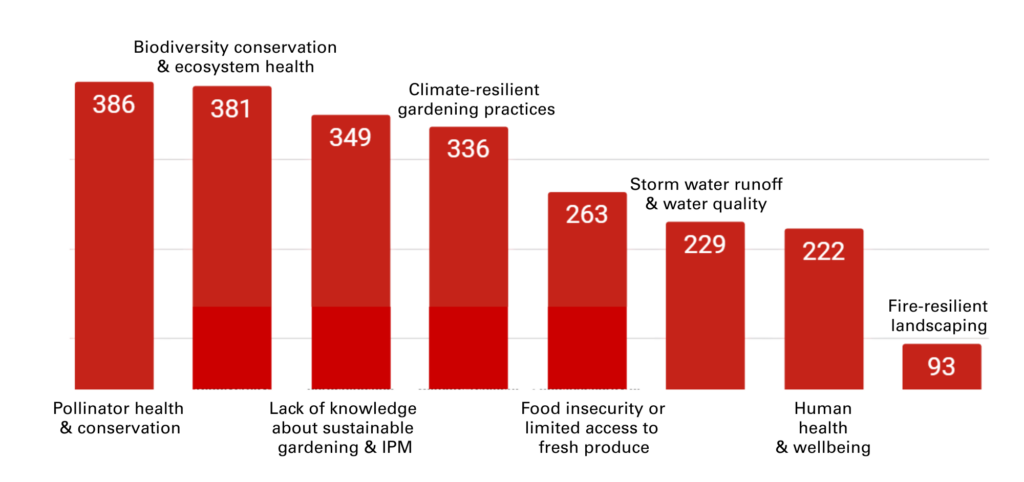
Rankings for eight community issues that can be addressed through gardening education.
Survey participants were asked to identify the most urgent issues in their communities that EMG volunteers could help address through gardening education.
The four highest-ranking priorities—each receiving more than 300 votes—reflect a strong, statewide emphasis on environmental sustainability and public education:
- Pollinator health and conservation – 386 votes
- Biodiversity conservation and ecosystem health – 381 votes
- Lack of knowledge about sustainable gardening and integrated pest management (IPM) – 349 votes
- Climate-resilient gardening practices – 336 votes
Other pressing concerns included:
- Food insecurity and limited access to fresh produce – 263 votes
- Stormwater runoff and water quality – 229 votes
- Human health and wellbeing – 222 votes
While fire-resilient landscaping received the fewest votes overall (93), it was a higher priority in districts that face increased wildfire risk—highlighting the need for regionally responsive strategies.
Most Needed Education and Outreach Efforts
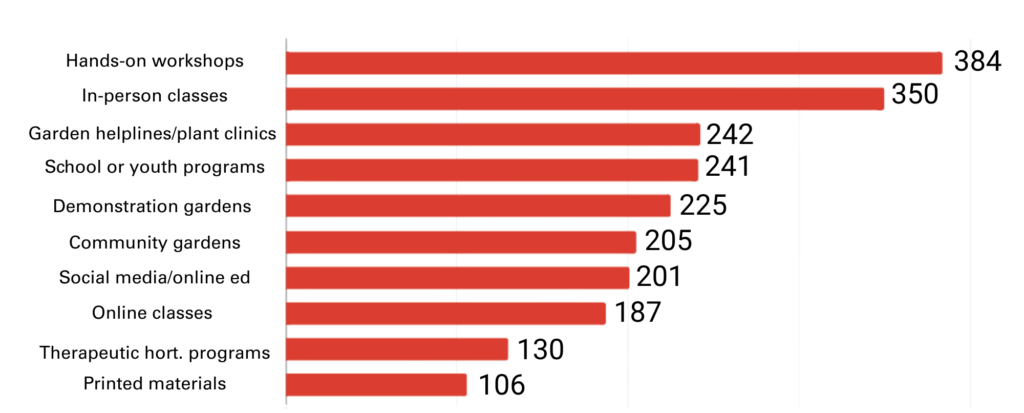
Respondents’ rankings for all ten outreach strategies.
To better understand how volunteers can address these issues, the survey asked respondents to select the outreach and education methods most needed in their counties.
The top choices reflect a continued preference for interactive, in-person learning experiences:
- Hands-on workshops – 384 votes
- In-person classes – 350 votes
Other frequently selected outreach methods included:
- Garden helplines and plant clinics – 242 votes
- School and youth programs – 241 votes
- Demonstration gardens – 225 votes
- Community gardens – 205 votes
Digital formats like social media and online education (201 votes) and online classes (187 votes) also received notable support, reflecting the value of flexible learning options.
Lower-ranked, but still relevant, activities included:
- Therapeutic horticulture programs – 130 votes
- Printed educational materials – 106 votes
Volunteer Training Priorities
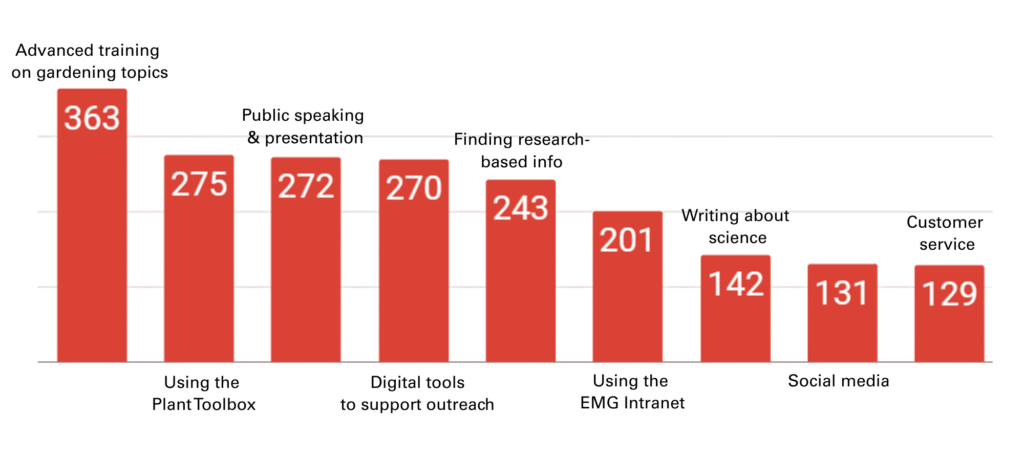
Prioritized rankings for nine training needs.
The survey asked respondents to identify the most important training needs to strengthen volunteer-led education and outreach.
The top priority—selected by 363 respondents—was advanced training in gardening topics directly related to pressing community needs, such as pollinator conservation, climate resilience, and sustainable gardening (as shown in the previous graph).
Other high-ranking training needs focused on both content knowledge and practical skills to enhance volunteer effectiveness:
- Using the Extension Gardener Plant Toolbox – 275 votes
- Public speaking and presentation skills – 272 votes
- Digital tools to support outreach – 270 votes
- Finding and applying research-based information – 243 votes
- Using the EMG Intranet effectively – 201 votes
While topics such as writing about science (142), using social media (131), and providing customer service (129) received fewer votes, they remain relevant, especially for volunteers involved in public-facing roles.
Statewide Tools and Resources to Support Outreach
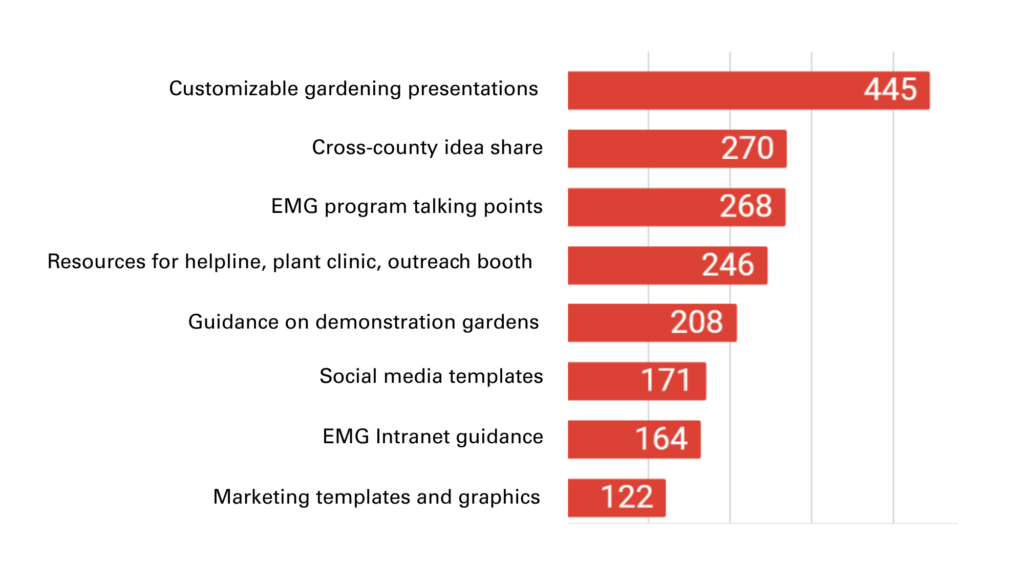
Respondents’ rankings for eight tools to support volunteer outreach.
The final section of the survey asked what tools, templates, or guidance—if provided at the state level—would most enhance volunteers’ ability to deliver impactful gardening education in their communities.
The most requested resource was customizable gardening presentations, which received 445 votes. This reflects a strong interest in adaptable, research-based materials that can be tailored to local needs.
Other highly rated resources included:
- Opportunities to share ideas across counties – 270 votes
- NC State EMG program talking points – 268 votes
- Resources for gardening infolines, plant clinics, and outreach booths – 246 votes
- Guidance on designing and using demonstration gardens – 208
Tools like social media templates (171), EMG Intranet guidance (164), and marketing templates and graphics (122) received fewer votes overall but still showed value for improving program visibility and consistency.
Who Participated in the Survey?
A total of 539 Master Gardener volunteers and 32 Extension professionals from across North Carolina participated in the survey.
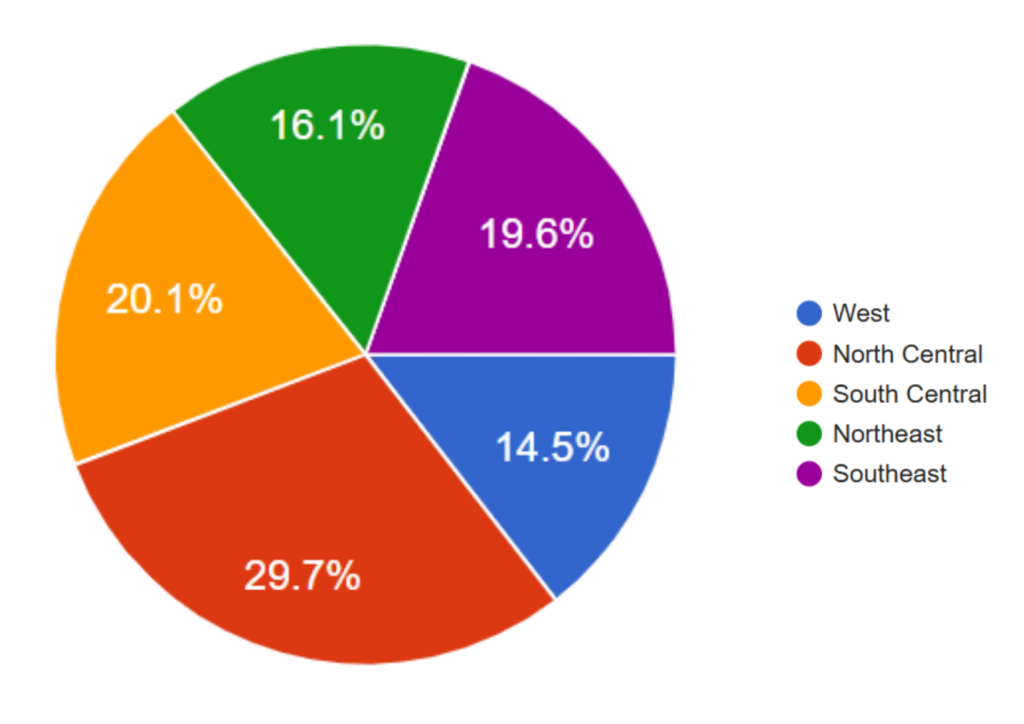
Distribution of survey respondents by Extension districts.
When asked where they participated in the EMG program, respondents were relatively evenly split among the five Extension districts. North Central had the greatest number of respondents, 30% (shown in red), followed by South Central (20%, yellow), Southeast (20%, purple), Northeast (16%, green), and West (14.5%, blue).
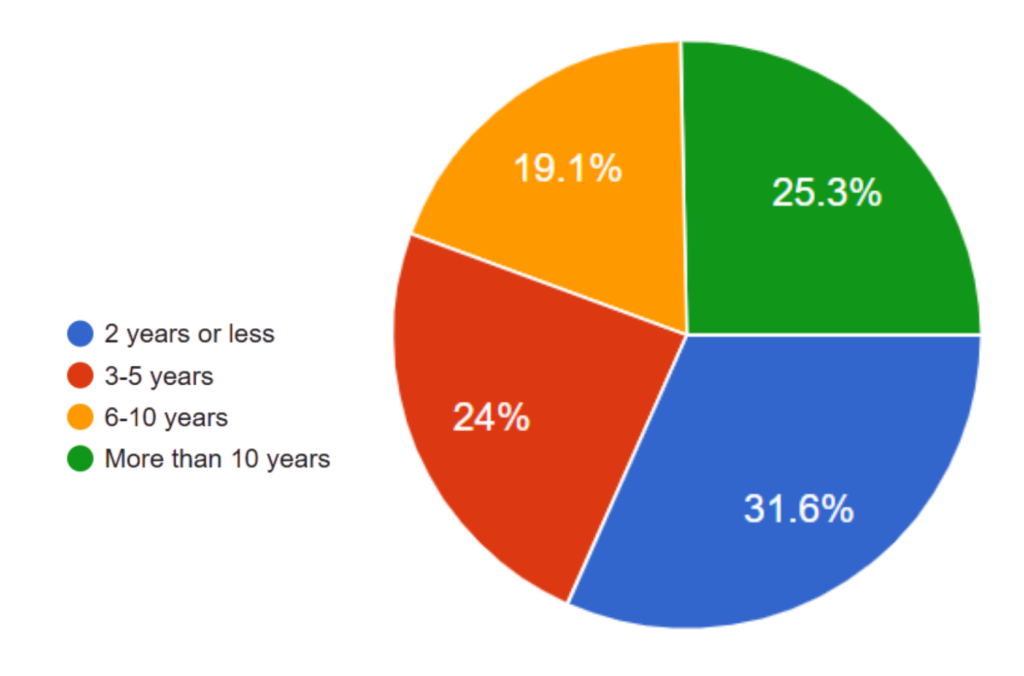
Survey participants tenure with the EMG program.
When asked how long they have been part of the EMG program as volunteers or employees, the greatest percentage at 31.6% (shown in blue) responded 2 years or less. This was followed by more than 10 years (25%, green), 3-5 years (24%, red), and 6-10 years (19%, yellow).
Looking Ahead
The insight shared through this survey provides a clear roadmap for growing the NC State Extension Master Gardener program’s relevance and impact. It will guide our efforts to develop statewide tools, enhance training opportunities, and support innovative outreach initiatives that address real needs in communities across North Carolina.
As we invest funding from the NC EMG Endowment and Day of Giving into these priorities, we remain grounded in our mission:
Empowering North Carolinians to cultivate healthy plants, landscapes, ecosystems, and communities through volunteer service that delivers research-based information, educational programming, and community outreach.
Go Link for this article: go.ncsu.edu/funding-priorities


